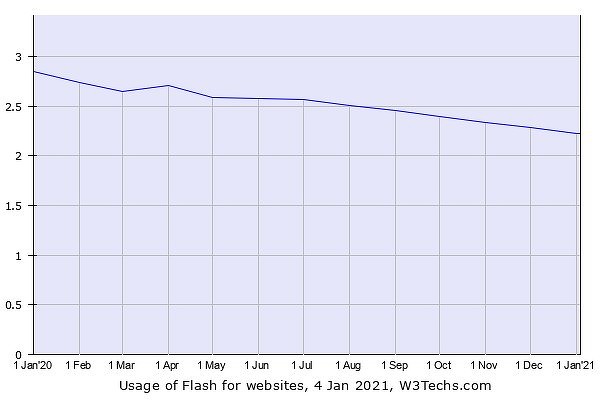
Replacing old technologies with new ones rarely goes without problems and worries. The most common incidents occur. With Adobe blocking Flash globally, many companies and government agencies are in trouble.
So, the railway network in the Chinese city of Dalian with a population of 4.4 million people was disconnected for a whole day, since most of the services ran on Flash. And, of course, in 24 hours the Chinese could not upgrade their network in any way, despite their well-known working capacity. I had to install an old version of Flash Player on all computers that supported the city's railway network.
Why did it happen?
In general, because of the principle of "works - do not touch". It is used not only by domestic, but also by foreign engineers. Yes, Adobe started warning about problems long before the shutdown, but Dalian's railway engineers were probably hoping that everything would be okay.
This is completely in vain, since the city's railroad website and services, which were used to sell tickets, publish train timetables, and other services, were powered exclusively by Flash. And all this turned into a pumpkin a couple of weeks ago (the incident became known recently).
On January 12, 2021, Adobe began blocking Flash content across the entire global network, and at the same time there was a failure in the timetable and booking system in a Chinese city. And if you consider that the population of this city is almost 5 million people, it becomes clear how problematic January 12 became for railway employees and passengers.
How it all started
The first call to the Dalian Railway staff came at 8:15 am on January 12th. After that, a real flurry of calls began. But even without them, the employees had something to do, since it was also impossible to connect to the internal site.
We must pay tribute - the Chinese quickly found a way out. They decided to install older versions of Flash Player on all PCs that did not have a sleep timer. In the new version, it was installed by Adobe, which warned about it many times.
After a while, the Chinese established a whole conveyor belt of employees. They were divided into two teams - software and hardware. The "software" team was busy reinstalling the Flash plug-in on the backup computers, while the "hardware" team replaced the working servers with the outdated plug-in with the backup servers with the new plug-in already demolished and the old one installed. The teams did this for about 20 hours.

The support team brings back the backup PCs with the old version of Flash installed. The
problem was solved only by 4:30 am the next day. All services of the railway started working again, the chaos was neutralized. According to company employees, no one complained, the whole team worked "as one person."
By the way, a little later the story, originally published in the Chinese media, was refuted by new publications, while the old ones were deleted.
Could problems have been avoided?
Generally, yes, since back in 2015, Adobe launched an information campaign to prepare users, including corporate ones, to abandon Flash. A gradual transition to HTML5 was planned, and in 2017 Adobe announced its intention to abandon Flash.
Large companies started rolling back almost immediately after Adobe's announcement. For example, Google has gradually turned off the technology in its browser, starting in December 2016. True, the company finally abandoned Flash only on December 31, 2020.
Microsoft also worked in this direction, which also began to gradually disable Flash support in its browsers since 2016. The company removed the technology entirely from Edge and Internet Explorer in 2019. There was still a new version of Edge based on Chromium - but here, for obvious reasons, the failure was implemented simultaneously with Google.
Opera and Firefox disabled Flash on January 1, 2021.
The very same company Adobe has set a "timer" for December 31, 2020. It turns out that users and companies, developers of Internet services and sites had several years to modernize the system.
As you can see, not everyone did this. On the other hand, the modernization of such a large-scale system requires a lot of resources - financial, time, etc. Therefore, perhaps, the Chinese did not change anything except the version of the plugin.
Why did they abandon Flash at all?
This technology has many vulnerabilities. It was simply not possible to eliminate them all, so Adobe decided to simply cut the knot. The vulnerabilities were both large and small. In 2014, for example, Kaspersky Lab specialists discovered a vulnerability that gave attackers full control over a user's machine. Moreover, it was relevant for all platforms where the technology was used, including Windows, Mac, Linux.

This was far from the only problem - vulnerabilities were discovered with enviable consistency, and not everything could be quickly eliminated. Therefore, instead of filling up the constantly emerging gaps, the technology was simply abandoned.
